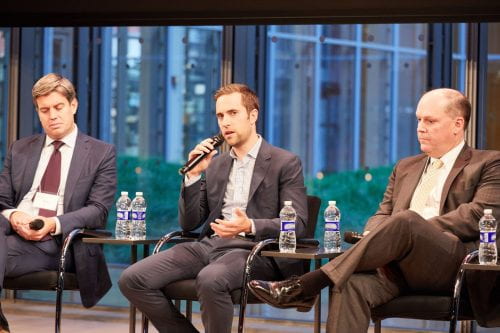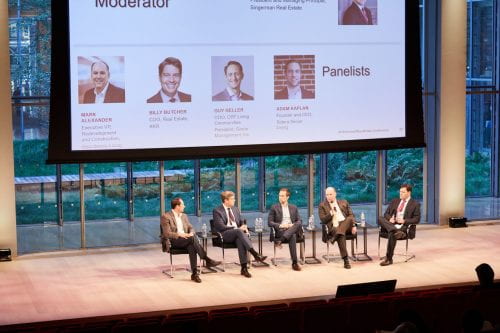An afternoon panel at the Cornell Real Estate Conference moderated by Seth Singerman (Singerman Real Estate) offered an insightful discussion about the senior housing market and the prospects of new developments in the space. Seth Singerman was joined by Mark Alexander (Atria Senior Living), Billy Butcher (KKR), Guy Geller (Grace Management), and Adam Kaplan (Solera Senior Living).
“The Silver Tsunami” refers to the soon expected wave of seniors maturing from the Baby Boomer generation. This demographic group makes up about a third of the population in the United States now with nearly 79 million people. As these people prepare for retirement the commercial real estate industry seeks to capitalize on the unique demographic shift by preparing to supply the inevitable need for senior housing. But in what form is this housing going to take shape, and how will real estate professionals differentiate their properties? The panelist shared some ideas, but one theme seems to prevail: For senior housing, lessons must be taken from the hospitality industry.
First, Seth Singerman asked the panel about why now is the time to focus on senior housing. The more recent market conditions in this asset class have shown that there was, in fact, a supply glut and related decline in senior occupancy. Singerman hinted that this information may counter the notion that additional senior living facilities are even necessary. Billy Butcher responded first, by saying that KKR’s bet on the demand for senior housing is expected to crop up about eight to ten years out. The others on the panel certainly agreed that while a recent oversupply has made the asset class less than appealing the demographics of an aging population are entirely unavoidable. Baby Boomers will need senior living facilities. It must be noted here that this is a bet on time and that time is arguably the only constant in any market. So then, where is the variability? Butcher specified three variables: (1) The operator – referring to the standards of quality implemented by the property managers, (2) the future supply – when and how new senior housing will be delivered, and (3) the value – the culture of the community including residents and staff. Alexander, Geller, and Kaplan were affirmative regarding these notions and Mark Alexander added that there is about a note about the number of people aging on a yearly basis. The US Census report projects that an average of 404,000 people will be aging between 80 and 84 on a yearly basis from 2020 to 2030.
Adam Kaplan highlighted the necessity for high-quality design and hospitality services which continued to showcase throughout the discussion. Think for a minute about the unique housing demands for a senior citizen. This demographic has an incredibly high rate of medical needs, accessibility is mandatory, and retirement has increased their reliance on a sense of community. Each of these needs leads to an operations-intensive property business model. When Singerman asked the panel about trends in the senior housing industry, it began to closely resemble a discussion that one might expect from the hotel industry. Both Geller and Kaplan expressed an increasing need for strong operations teams on the property management level. That, however, brings some difficulty because attracting and retaining good talent often means paying higher salaries. While these higher salaries are most certainly warranted, they must be funded by increases in rental prices. Increases in rental prices are difficult in senior housing facilities for two primary reasons: (1) many of the tenants are living on a fixed income, and (2) these tenants tend to hold their leases by staying put for long periods of time.
The senior housing industry is going to face a unique increase in demand that heralds an abundance of market opportunities for developers, investors, and managers. However, it is not without hurdles. It seems that the most successful businesses in this space will be able to differentiate themselves by various means. The best senior living properties will need to be managed like hotels with considerable resources allocated to the care for the resident community. This includes access to medical assistance as well as amenities that encourage gath ering, health, and general wellbeing. These tenants are elderly people who will likely be moving into these properties from local neighborhoods. They may also have families with grandchildren nearby that will come to visit so accommodation for these guests would probably be a benefit that sets one property apart from the others. In fact, the panel discussion focused on the notion that many of their tenants lived approximately thirty minutes away from the senior housing facilities in which they choose to live.
ering, health, and general wellbeing. These tenants are elderly people who will likely be moving into these properties from local neighborhoods. They may also have families with grandchildren nearby that will come to visit so accommodation for these guests would probably be a benefit that sets one property apart from the others. In fact, the panel discussion focused on the notion that many of their tenants lived approximately thirty minutes away from the senior housing facilities in which they choose to live.
There is a unique opportunity in providing housing to folks who are, actuarially speaking, at the final stages of their lives. Proper care and spatial synergy must be considered when creating and managing property for these people. These trends in experience-based design are emerging across all types of real estate assets. In the senior living space, it has become clear that the demand is set to increase, and the operational strategies will be challenging but will create significant opportunities for developers and property managers to deliver unique senior housing facilities to the market.

